If you’re going to fly in space, you need some kind of propulsion system. Chemical rockets can accelerate quickly, but they need a lot of heavy fuel. Ion engines are extremely fuel efficient but don’t generate a lot of power, so they accelerate over months and even years. A new thrusting technology called the Helicon Double Layer Thruster could be even more efficient with its fuel. Dr. Christine Charles from the Australian National University in Canberra is the inventor.
Continue reading “Podcast: Plasma Thruster Prototype”
Podcast: Plasma Thruster Prototype
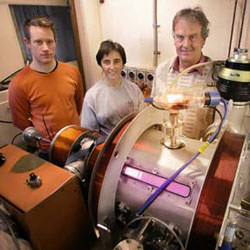
Dr. Charles and the ANU HDLT team. Image credit: ANU. Click to enlarge.
Listen to the interview: Plasma Thruster Prototype (5.5 MB)
Or subscribe to the Podcast: universetoday.com/audio.xml
Fraser: Can you give me some background on the thrusting technology you’ve invented?
Dr. Christine Charles: Okay, this thruster is called the HDLT, which stands for Helicon Double Layer Thruster, and it’s a new type of plasma thruster application into deep space travel. And the background is our expertise in plasma technologies, space plasma, plasma processing for treating surfaces and a variety of other applications.
Fraser: So, the favourite engine of the space exploration set these days is the ion engine, which has demonstrated quite good performance as a fuel efficient engine. How does the engine you’re working on relate to an ion engine? Can you give people some context?
Dr. Charles: Yes, there are some common aspects and some very different aspects. So, first the ion engine has been successfully developed for the past – I don’t know – 50 years or so. It’s quite well developed now. But the HD thruster has some interesting advantages. First, it doesn’t use any electrodes. So in the ion engine, you have a series of grids to accelerate the ion. So our thruster doesn’t have electrodes, we have a new type of acceleration mechanism that we call the Double Layer. This is why we call it HDLT: Helicon Double Layer Thruster. It has no electrodes, so that means it has a long lifetime because you don’t have electrode erosion. And a second, really important aspect is if you look at devices like ion engines, they emit ions. So you need to have an external source of electrons to neutralize these ions, and that’s generally done by having a second device on the side of the thruster which is called a hollow cathode device. In fact you have two devices on an ion engine. And often because they’re afraid that these hollow cathode devices might fail, they put two of them on to increase the lifetime. But in the HDLT, we actually emit a plasma, which in itself contains a supersonic ion beam. So we have the supersonic ion beam, which is the main source of thrust as it exits the thruster, but we also have the plasma which emits just enough electrons to neutralize the beam. So we don’t need this external device which is the neutralizer. That’s very good because it can provide safety, and simplicity – there’s no moving parts – so it makes the HDLT quite attractive for very deep space travel; long lifetime. And another advantage is that because we use a second concept called helicon plasma, it’s a very efficient way of transferring electricity into the charged particles in the plasma. That means we can get really dense plasmas with a lot of ions and we can scale up in power. So, we can probably go up to 100 kilowatts. This hasn’t been done yet here in a prototype, because our first prototype was just 1 kilowatt. But other experiments have suggested that with our type of plasma, we can really scale up in power, and to do that with an ion engine, basically the main thing is that when you go above a few kilowatts, you have to have a cluster of thrusters.
So I would say that it’s really early days for the HDLT, but the main advantages are increased lifetime, simplicity, scalability, and safety. And it’s also quite fuel efficient, which is very good.
Fraser: In terms of performance, ion engines can put out the thrust of the weight of a piece of paper, but they can do it for years and years and build up thrust. You’re saying that you could put out more thrust?
Dr. Charles: At the moment, ion engines are definitely the best in terms of thrust, for kilowatt, at the moment. And the HDLT prototype, which is just a concept and under 1 kilowatt, it doesn’t match the thrust. If you take the example of an ion engine, it typically has 100 milli newtons for one kilowatt. We’re talking probably 3-5 times less at the moment, but you have to see that we haven’t had 20 years of development. It’s early days, and we can certainly improve the technology.
Fraser: And then as I understand now, the European Space Agency has picked up the technology and is doing some in-house testing. And how’s that gone for them?
Dr. Charles: Okay, they had a few projects. The first thing is that we had a grant in Australia from a funding agency, and that was during 2004-2005. And we designed and manufactured the first HDLT prototype, which we brought to ESA last April, and which we tested for a month. We had limited funding so we couldn’t test it for more than a month. And this showed that all aspects of the thruster worked perfectly. But we tested all the powers that we could, and we had different gas pressures, etc. We didn’t have the diagnostics we needed to measure the thrust, so we didn’t know what the actual thrust was. The thrust that we have is what we can measure from the ion beam in Australia – it still has to be done. And it’s based on this very new concept of the double layer, which we had to convince people about. And ESA thought it was really interesting, so they had decided to have an independent study to validate the double layer effect. It’s the basic concept behind the thruster; the acceleration mechanism. So now we really have to see what this is about.
What is a double layer? You can just imagine, it’s like a river and suddenly the bed of the river falls down so that a waterfall is created. Then you have these ions which fall down this waterfall, and get accelerated and then get connected to the rocket with a large exhaust velocity. So the double layer is a potential drop in the plasma. What’s very interesting is that in the HDLT, we don’t have any electrodes; the plasma just decides to do this, by using a certain magnetic field, which is a magnetic bottle or nozzle. And that’s all. So it’s like having the waterfall without pumping the water through. So this is the basic concept.
So ESA had this independent study to validate the concept of the double layer. Have you seen the latest press release?
Fraser: Yes, I have.
Dr. Charles: So there was this latest study by Australia. We have the first prototype, and we have demonstrated some aspects; although, the thrust hasn’t been measured in a space simulation chamber yet. And ESA has also validated the concept behind the thruster, which is this double layer concept. So that’s where we’re at at the moment.
Fraser: So what kinds of missions do you think the HDLT thruster would be better for?
Dr. Charles: It has to be for really long term missions where you’re forced to go slowly, but for a long time. And it’s also has this nice safety aspect. It has the potential to be used for manned spaceflight. So it’s really for deep space missions, or going to Mars… things like that.
Fraser: I see. I guess one of its main advantages here is that it has less moving parts – parts that could break down.
Dr. Charles: And it can be scaled up in power, which is also important. NASA has made a simulation of what type of power you would need to send humans to Mars, and it’s in the megawatt range. So you will have to have the power. You’ll need to be able to scale up your thrusters as well. They need to be able to operate under large power to do the job. What NASA did is show that if you could have a proper plasma thruster, or plasma rocket, you could cut down the time to go to Mars because if you use plasma technology, you can use geodesic trajectories. If you use chemical propulsion, you’ll have more like a ballistic trajectory. So you can cut down on the time travel to Mars for example.
Fraser: So what are the next steps for your research?
Dr. Charles: Well, we’re doing various things in parallel. We’re still working very strongly on the double layer itself because this is a very nice kind of physics that has all kinds of other applications to the aurora, or solar wind acceleration, etc. We also have a new space simulation chamber here at the Australian National University. And we have mounted the prototype, which is back from ESA, into that space simulation chamber. And we’re going to start trying to measure the thrust balance and other ways, probably from January 2006. And there might be other news happening, I don’t know. We’ll see how it goes. We’ll definitely be putting a lot of effort into this subject. It’s very fascinating because many people are interested in the outcome.
HDLT Thruster Information from ANU
Stardust is Almost Home
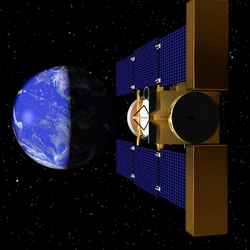
Artist’s impression of Stardust returning back to Earth. Image credit: NASA/JPL Click to enlarge
NASA’s Stardust mission is nearing Earth after a 4.63 billion kilometer (2.88 billion mile) round-trip journey to return cometary and interstellar dust particles back to Earth. Scientists believe the cargo will help provide answers to fundamental questions about comets and the origins of the solar system.
The velocity of the sample return capsule, as it enters Earth’s atmosphere at 46,440 kilometers per hour (28,860 miles per hour), will be the fastest of any human-made object on record. It surpasses the record set in May 1969 during the return of the Apollo 10 command module. The capsule is scheduled to return on Jan. 15, 2006.
“Comets are some of the most informative occupants of the solar system. The more we can learn from science exploration missions like Stardust, the more we can prepare for human exploration to the moon, Mars and beyond,” said Dr. Mary Cleave, associate administrator for NASA’s Science Mission Directorate.
Several events must occur before scientists can retrieve cosmic samples from the capsule landing at the U.S. Air Force Utah Test and Training Range, southwest of Salt Lake City. Mission navigators will command the spacecraft to perform targeting maneuvers on Jan. 5 and 13. On Jan 14 at 9:57 p.m. PST (12:57 a.m. EST on Jan. 15), Stardust will release its sample return capsule. Four hours later, the capsule will enter Earth’s atmosphere 125 kilometers (410,000 feet) over the Pacific Ocean.
The capsule will release a drogue parachute at approximately 32 kilometers (105,000 feet). Once the capsule has descended to about 3 kilometers (10,000 feet), the main parachute will deploy. The capsule is scheduled to land on the range at 2:12 a.m. PST (5:12 a.m. EST).
After the capsule lands, if conditions allow, a helicopter crew will fly it to the U.S. Army Dugway Proving Ground, Utah, for initial processing. If weather does not allow helicopters to fly, special off-road vehicles will retrieve the capsule and return it to Dugway. Samples will then be moved to a special laboratory at NASA’s Johnson Space Center, Houston, where they will be preserved and studied.
“Locked within the cometary particles is unique chemical and physical information that could be the record of the formation of the planets and the materials from which they were made,” said Dr. Don Brownlee, Stardust principal investigator at the University of Washington, Seattle.
NASA expects most of the collected particles to be no more than a third of a millimeter across. Scientists will slice these particle samples into even smaller pieces for study.
NASA’s Jet Propulsion Laboratory, Pasadena, Calif. manages the Stardust mission for NASA’s Science Mission Directorate, Washington. Lockheed Martin Space Systems, Denver, developed and operates the spacecraft.
For information about the Stardust mission on the Web, visit http://www.nasa.gov/stardust .
Original Source: NASA News Release
The Source of Killer Electrons
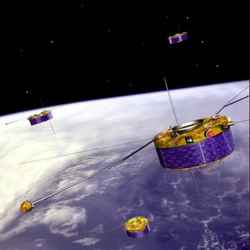
Artist’s illustration of ESA’s Cluster spacecraft floating above Earth. Image credit: ESA Click to enlarge
ESA’s Cluster mission has revealed a new creation mechanism of ‘killer electrons’ – highly energetic electrons that are responsible for damaging satellites and posing a serious hazard to astronauts.
Over the past five years, a series of discoveries by the multi-spacecraft Cluster mission have significantly enhanced our knowledge of how, where and under which conditions these killer electrons are created in Earth?s magnetosphere.
Early satellite measurements in the 1950s revealed the existence of two permanent rings of energetic particles around Earth.
Usually called the ‘Van Allen radiation belts’, they are filled with particles trapped by Earth’s magnetic field. Observations showed that the inner belt contains a fairly stable population of protons, while the outer belt is mainly composed of electrons in a more variable quantity.
Some of the outer belt electrons can be accelerated to very high energies, and it is these ‘killer electrons’ that can penetrate thick shielding and damage sensitive satellite electronics. This intense radiation environment is also a threat to astronauts.
For a long time scientists have been trying to explain why the number of charged particles inside the belts vary so much. Our major breakthrough came when two rare space storms occurred almost back-to-back in October and November 2003.
During the storms, part of the Van Allen radiation belt was drained of electrons and then reformed much closer to the Earth in a region usually thought to be relatively safe for satellites.
When the radiation belts reformed they did not increase according to a long-held theory of particle acceleration, called ‘radial diffusion’. Radial diffusion theory treats Earth’s magnetic field lines as being like elastic bands.
If the bands are plucked, they wobble. If they wobble at the same rate as the particles drifting around the Earth then the particles can be driven across the magnetic field and accelerated. This process is driven by solar activity.
Instead, a team of European and American scientists led by Dr Richard Horne of the British Antarctic Survey, Oxford, UK, used data from Cluster and ground receivers in Antarctica to show that very low frequency waves can cause the particle acceleration and intensify the belts.
These waves, named ‘chorus’, are natural electromagnetic emissions in the audio frequency range. They consist of discrete elements of short duration (less than one second) that sound like the chorus of birds singing at sunrise. These waves are among the most intense in the outer magnetosphere.
The number of ‘killer electrons’ can increase by a factor of a thousand at the peak of a magnetic storm and in the following days. Intense solar activity can also push the outer belt much closer to Earth, therefore subjecting lower altitude satellites to a much harsher environment than they were designed for.
The radial diffusion theory is still valid in some geophysical conditions. Before this discovery, some scientists thought that chorus emissions were not sufficiently efficient to account for the reformation of the outer radiation belt. What Cluster has revealed is that in certain highly disturbed geophysical conditions, chorus emissions are sufficient.
Thanks to the unique multipoint measurements capability of Cluster, the characteristic dimensions of these chorus source regions have been estimated for the first time.
Typical dimensions have been found to be a few hundred kilometres in the direction perpendicular to the Earth’s magnetic field and a few thousands of kilometres in the direction parallel to this.
However, the dimensions found so far are based on case studies. “Under disturbed magnetospheric conditions, the chorus source regions form long and narrow spaghetti-like objects. The question now is whether those very low perpendicular scales are a general property of the chorus mechanism, or just a special case of the analysed observations,” said Ondrej Santolik, of Charles University, Prague, Czech Republic, and main author of this result.
Due to our increased reliance on space based technologies and communications, the understanding of how, under which conditions and where these killer electrons are created, especially during magnetic storm periods, is of great importance.
Original Source: ESA Portal
Has Beagle 2 Been Found?
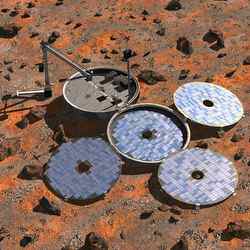
Artist’s impression of Beagle 2 lander. Image credit: ESA Click to enlarge
The news that Beagle 2 may have been spotted on the surface of Mars in the immediate vicinity of where it was expected to land was welcomed by the European Space Agency.
ESA?s Mars Express spacecraft had delivered the Beagle 2 lander to Mars on 25 December 2003.
ESA?s Director of Science David Southwood said, “If this turns out to be a definitive sighting then we can feel very pleased not only for the Beagle 2 team but also for everyone else involved in getting the probe to Mars and accurately into its descent.”
“Although the discovery cannot make up for the loss of science, there can be more confidence that Beagle 2 made it down to the surface. The search itself has been not been easy and it says something for the persistence and dedication of the team that this report has emerged.”
It is also important if the scenario of impact, as outlined by the team on the basis of the NASA Mars Global Surveyor spacecraft images, can be further investigated.
“This information, if consolidated, can limit what might have gone wrong two years ago and we can use it to increase our own confidence and faith in the methods used when we next face the challenge of going to Mars,” added Southwood.
ESA received the go-ahead for a new European lander mission to Mars, Exomars, with the subscription by Member States for a new exploration programme, Aurora, just a few weeks ago at the ESA Council of Ministers in Berlin on 5-6 December 2005.
Original Source: ESA Portal
Mission to Mars via Antarctica
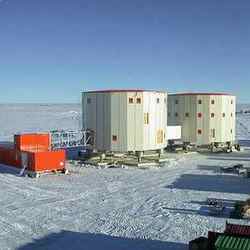
Concordia Station in Antarctica. Image credit: IPEV Click to enlarge
A few weeks before leaving for the Antarctic Concordia Station, the Italian-French crew that will spend over one year in one of the harshest, isolated environments on Earth, attended two days of preparatory training at ESA’s Headquarters in Paris, France. During their stay at the research station the crew will participate in a number of ESA experiments ? the outcome of which will help prepare for long-term missions to Mars.
As part of the Aurora Exploration Programme, ESA is considering participating in a human mission to Mars by the year 2030. Research projects are planned or are already underway to develop the technology and knowledge needed. By being involved in programmes that have requirements similar to those of a mission to Mars, ESA will gain experience on how best to prepare for such a challenging mission.
“The Concordia Station is an ideal location as it replicates certain aspects of a Mars mission,” explains Oliver Angerer, ESA’s coordinator for the Concordia research programme. “The crew lives in an extreme environment in one of the most remote places on Earth. During the winter the base is completely cut off with no visitors and no chance for rescue. In such an isolated location, the crew has to learn to be fully self-sufficient.”
Cooperation
Built and operated jointly by the French Polar Institute (Institute Paul Emile Victor, IPEV) and the Italian Antarctic Programme (Consorzio per l?attuazione del Programma Nazionale di Richerche in Antartide, PNRA S.C.r.l.), the Concordia Station was completed in 2004. A letter of intent was signed with IPEV and PNRA in 2002 that enabled ESA to cooperate on some aspects of the project.
Capable of providing home to up to 16 crewmembers in the winter, the station consists of three buildings, which are interlinked by enclosed walkways. Two large cylindrical three-storey buildings provide the station’s main living and working quarters, whilst the third building houses technical equipment, like the electrical power plant and boiler room.
Last November, the first crew finished their winter-over which was dedicated to the technical qualification of the station . The summer season sees a swelling in the number of inhabitants as short-stay scientists take advantage of the less extreme weather (however, mean air temperature is about -30?C during this time!). With the second crew now starting to gather at the remote research station, the summer season also marks a change over of the crew.
Briefings
Three scientists who are part of the next Concordia winter-over crew have already made the long journey to Antarctica. The rest of the crew, who will leave for the Antarctic research station during December, gathered at ESA’s Headquarters in Paris for two days of pre-departure training. They received briefings about life at Concordia, including aspects such as safety and the implications of the Antarctic Treaty for activities at the station.
The seven crewmembers also heard about research at the station, including two special experiments for which they will act as subjects during their stay. In 2003, ESA coordinated together with the Concordia partners a Research Announcement for medical and psychological research, from which six proposals were selected.
The two experiments, which are the first to be implemented in the coming season, look at psychological adaptation to the environment and the process of developing group identity; issues that will also be important factors for humans travelling to Mars. For this research the crew will complete questionnaires at regular intervals throughout their stay.
ESA’s Mistacoba experiment, which already started a year ago when the first crew started living at the station, will also continue after the crew rotation. Starting from a newly built clean environment, samples are taken from fixed locations in the base as well as from crewmembers themselves. The Mistacoba experiment will provide a profile of how microbes spread and evolve in the station – an isolated and confined environment – over time.
Water-recycling
To protect the Antarctic environment, all waste materials must be removed from the Continent. For the Concordia Station, this means that all waste materials have to be appropriately treated. Regarding water, based on ESA life support technologies, ESA developed, together with PNRA and IPEV, a system to recycle the so-called ‘grey water’ collected from showers, laundry and dishwashing, which has been operating for a year in line with the requirements of the Concordia partners.
Other ESA activities for Concordia include the ongoing development of a system to monitor the health and well being of the crew, part of the Long Term Medical Survey (LMTS). Physiological parameters, collected using a vest-like item of clothing, will provide valuable data about the health and fitness of crew during long-term stays in harsh environments.
Real environment
In mid-February the last plane of summer visitors will depart from Concordia leaving the crew to their own devices. “For those nine winter months the crew will experience extreme isolation,” adds Oliver Angerer. “Concordia is a real operational environment, something we would never be able to simulate in a laboratory. This will enhance and complement our research and give us valuable insight we need to prepare for Mars.”
Original Source: ESA Portal
Mimas and Tiny Helene
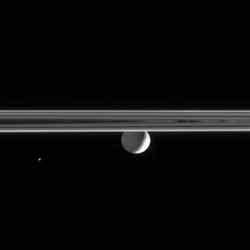
Mimas and the small Trojan moon Helene. Image credit: NASA/JPL/SSI. Click to enlarge
Gazing across the ringplane, the Cassini spacecraft spots a Saturn-lit Mimas and the tiny Trojan moon Helene. Only the bright crescent on Mimas’ eastern limb is lit by the Sun; the moon’s night side is illuminated by Saturnshine, or “greylight” as it is called by imaging scientists.
Helene (32 kilometers, or 20 miles across) shares the orbit of Dione (not pictured here) and is visible as a speck to the left of Mimas. This view shows the Saturn-facing side of Mimas (397 kilometers, or 247 miles across).
The image was taken in visible light with the Cassini spacecraft narrow-angle camera on Nov. 2, 2005, at a distance of approximately 2 million kilometers (1.2 million miles) from Mimas and at a Sun-Mimas-spacecraft, or phase, angle of 121 degrees. Helene was about 2.2 million kilometers (1.4 million miles) distant. The image scale is 12 kilometers (7 miles) per pixel on Mimas.
The Cassini-Huygens mission is a cooperative project of NASA, the European Space Agency and the Italian Space Agency. The Jet Propulsion Laboratory, a division of the California Institute of Technology in Pasadena, manages the mission for NASA’s Science Mission Directorate, Washington, D.C. The Cassini orbiter and its two onboard cameras were designed, developed and assembled at JPL. The imaging operations center is based at the Space Science Institute in Boulder, Colo.
For more information about the Cassini-Huygens mission visit http://saturn.jpl.nasa.gov . The Cassini imaging team homepage is at http://ciclops.org .
Original Source: NASA/JPL/SSI News Release
Echoes from Ancient Supernovae
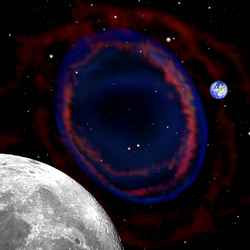
An artist’s concept of a hypothetical supernova in our galaxy. Image credit: David A. Aguilar (CfA). Click to enlarge
A team of astronomers has found faint visible echoes of three ancient supernovae by detecting their centuries-old light as it is reflected by clouds of interstellar gas hundreds of light-years removed from the original explosions.
Located in a nearby galaxy in the southern skies of Earth, the three exploding stars flashed into short-lived brilliance at least two centuries ago, and probably longer. The oldest one is likely to have occurred more than six hundred years ago.
The light echoes were discovered by comparing images of the Large Magellanic Cloud (LMC) taken years apart. By precisely subtracting the common elements in each image of the galaxy and looking by eye to see what variable objects remain, the team looked for evidence of invisible dark matter that might distort the light of stars in a transitory way, as part of a sky survey called SuperMACHO.
This careful image analysis also revealed a small number of concentric, circular-shaped arcs that are best explained as light moving outward over time, and being scattered as it encounters dense pockets of cool interstellar dust. Team members then fit perpendicular vectors to the curves of each arc system, which were found to point backwards toward the sites of three supernovae remnants, which were previously known and thought to be relatively young.
“Without the geometry of the light echo, we had no precise way of knowing just how old these supernovae were,” said astronomer Armin Rest of the National Optical Astronomy Observatory (NOAO), lead author of a paper on the discovery in the December 22, 2005, issue of Nature. “Some relatively simple mathematics can help us answer one of the most vexing questions that astronomers can ask-exactly how old is this object that we are looking at?”
Just as a sound echo can occur when sound waves bounce off a distant surface and reflect back toward the listener, a light echo can be seen when light waves traveling through space are reflected back toward the viewer-in this case, the Mosaic digital camera on the National Science Foundation’s Blanco 4-meter telescope at Cerro Tololo Inter-American Observatory (CTIO) in Chile.
This technique can be extended to famous supernovae in history. “Imagine seeing light from the same explosion first seen by Johannes Kepler some 400 years ago, or the one recorded by Chinese observers in 1006,” said Christopher Stubbs of the Harvard-Smithsonian Center for Astrophysics (CfA), co-author of the paper and principal investigator for the SuperMACHO program. “These light echoes give us that possibility.”
In principle, astronomers can split the light echo into a spectrum to investigate what type of supernova occurred. “We have the potential with these echoes to determine the star’s cause of death, just like the archaeologists who took a CT scan of King Tut’s mummy to find out how he died,” said co-author Arti Garg of CfA.
Astronomers can also use supernova light echoes to measure the structure and nature of the interstellar medium. Dust and gas between the stars are invisible unless illuminated by some light source, just as fog at night is not noticeable until lit by a car’s headlights. A supernova blast can provide that illumination, lighting up surrounding clouds of matter with its strobe-like flash.
“We see the reflection as an arc because we are inside an imaginary ellipse, with the Earth at one focus of the ellipse and the ancient supernovae at the other,” explained Nicholas Suntzeff of NOAO. “As we look out toward the supernovae, we see the reflection of the light echo only when it intersects the outer surface of the ellipse. The shape of the reflection from our vantage point appears to be a portion of a circle.”
An unusual aspect of the arcs is that they generally appear to move much faster than the speed of light. This does not violate the cosmic speed limit, which states that any object cannot move faster than the speed of light. “What our telescopes see is the reflection moving, and not any physical object,” Suntzeff added. “It is also very exciting that our observations confirm the visionary prediction of Fritz Zwicky in 1940 that light from ancient supernovae could be seen in echoes of the explosion.”
Two additional high-resolution color graphics to illustrate this result are available at http://www.noao.edu/outreach/press/pr05/pr0512.html.
Other co-authors of the Nature paper are Knut Olsen and Chris Smith (CTIO); Jose Luis Prieto (Ohio State University); Douglas Welch (McMaster University, Ontario); Andrew Becker and Gajus Miknaitis (University of Washington); Marcel Bergmann (Gemini Observatory); Alejandro Clocchiatti and Dante Minniti (Pontifica Universidad Catolica de Chile); and, Kem Cook, Mark Huber and Sergei Nikolaev (Lawrence Livermore).
Headquartered in Cambridge, Mass., the Harvard-Smithsonian Center for Astrophysics (CfA) is a joint collaboration between the Smithsonian Astrophysical Observatory and the Harvard College Observatory. CfA scientists, organized into six research divisions, study the origin, evolution and ultimate fate of the universe.
Original Source: CfA News Release
Clearer Images of the Milky Way’s Centre
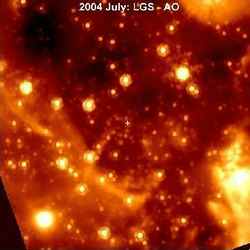
The center of our Milky Way galaxy captured by Keck Laser Guide Star. Image credit: W.M. Keck Observatory/UCLA Click to enlarge
UCLA astronomers and colleagues have taken the first clear picture of the center of our Milky Way galaxy, including the area surrounding the supermassive black hole, using a new laser virtual star at the W.M. Keck observatory in Hawaii.
“Everything is much clearer now,” said Andrea Ghez, UCLA professor of physics and astronomy, who headed the research team. “We used a laser to improve the telescope’s vision ? a spectacular breakthrough that will help us understand the black hole’s environment and physics. It’s like getting Lasik surgery for the eyes, and will revolutionize what we can do in astronomy.”
Astronomers are used to working with images that are blurred by the Earth’s atmosphere. However, a laser virtual star, launched from the Keck telescope, can be used to correct the atmosphere’s distortions and clear up the picture. This new technology, called Laser Guide Star adaptive optics, will lead to important advances for the study of planets in our solar system and outside of our solar system, as well as galaxies, black holes, and how the universe formed and evolved, Ghez said.
“We have worked for years on techniques for ‘beating the distortions in the atmosphere’ and producing high-resolution images,” she said. “We are pleased to report the first Laser Guide Star adaptive optics observations of the center of our galaxy.”
Ghez and her colleagues took “snapshots” of the center of the galaxy, targeting the supermassive black hole 26,000 light years away, at different wavelengths. This approach allowed them to study the infrared light emanating from very hot material just outside the black hole’s “event horizon,” about to be pulled through.
“We are learning the conditions of the infalling material and whether this plays a role in the growth of the supermassive black hole,” Ghez said. “The infrared light varies dramatically from week to week, day to day and even within a single hour.”
The research, federally funded by the National Science Foundation, will be published Dec. 20 in the Astrophysical Journal Letters.
The research was conducted using the 10-meter Keck II Telescope, which is the world’s first 10-meter telescope with a laser on it. Laser Guide Star allows astronomers to “generate an artificial bright star” exactly where they want it, which reveals the atmosphere’s distortions.
Since 1995, Ghez has been using the W.M. Keck Observatory to study the galactic center and the movement of 200 nearby stars.
Black holes are collapsed stars so dense that nothing can escape their gravitational pull, not even light. Black holes cannot be seen directly, but their influence on nearby stars is visible, and provides a signature, Ghez said. The supermassive black hole, with a mass more than 3 million times that of our sun, is in the constellation of Sagittarius. The galactic center is located due south in the summer sky.
The black hole came into existence billions of years ago, perhaps as very massive stars collapsed at the end of their life cycles and coalesced into a single, supermassive object, Ghez said.
Co-authors on the research include UCLA graduate students Seth Hornstein and Jessica Lu; the adaptive optics team at W. M. Keck Observatory: David Le Mignant, Marcos Van Dam and Peter Wizinowich; Antonin Bouchez (formerly with the W. M. Keck Observatory) and Keith Matthews at Caltech; Mark Morris, a UCLA professor of physics and astronomy; and Eric Becklin, a UCLA professor of physics and astronomy.
Ghez provides more information, and images of the galactic center, at http://www.astro.ucla.edu/research/galcenter/.
Original Source: UCLA News Release
Alpha Centauri’s Sounds Measured
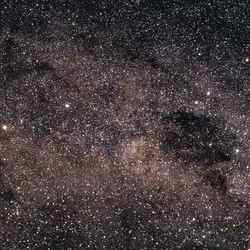
Alpha Centauri and the Southern Cross. Image credit: ESO Click to enlarge
Astronomers have used ESO’s Very Large Telescope in Chile and the Anglo-Australian Telescope in eastern Australia as a ‘stellar stethoscope’ to listen to the internal rumblings of a nearby star. The data collected with the VLT have a precision better than 1.5 cm/s, or less than 0.06 km per hour!
By observing the star with two telescopes at the same time, the astronomers have made the most precise and detailed measurements to date of pulsations in a star similar to our Sun. They measured the rate at which the star’s surface is pulsing in and out, giving clues to the density, temperature, chemical composition and rotation of its inner layers – information that could not be obtained in any other way.
The astronomers from Denmark, Australia, and the USA used Kueyen, one of the four 8.2-m Unit Telescopes of ESO’s Very Large Telescope (VLT) at Cerro Paranal in Chile, and the 3.9-m Anglo-Australian Telescope (AAT) in New South Wales (Australia), to study the star Alpha Centauri B, one of our closest neighbours in space, about 4.3 light-years away.
Alpha Centauri is the brighter of the two ‘Pointers’ to the Southern Cross. Alpha Centauri itself is a triple system and Alpha Centauri B is an orange star, a little cooler and a little less massive than the Sun.
Churning gas in the star’s outer layers creates low-frequency sound waves that bounce around the inside of the star, causing it to ring like a bell. This makes the star’s surface pulsate in and out by very tiny amounts – only a dozen metres or so every four minutes. Astronomers can detect these changes by measuring the small, associated wavelength shifts.
The researchers sampled the light from Alpha Centauri B for seven nights in a row, making more than 5 000 observations in all. At the VLT, 3379 spectra were obtained with typical exposure times of 4 seconds and a median cadence of one exposure every 32 seconds! At the AAT 1642 spectra were collected, with typical exposures of 10 s, taken every 90 s.
“From this unique dataset, we were able to determine as many as 37 different patterns (or modes) of oscillation”, says Hans Kjeldsen, from University of Aarhus (Denmark) and lead author of the paper describing the results.
The astronomers also measured the mode lifetimes (how long the oscillations last), the frequencies of the modes, and their amplitudes (how far the surface of the star moves in and out). Such measurements are a huge technical challenge. Indeed, the star’ surface moves slowly, at the tortoise-like speed of 9 cm a second, or about 300 metre an hour. The astronomers borrowed their high-precision measurement technique from the planet-hunters, who also look for slight Doppler shifts in starlight.
“So much of what we think we know about the universe rests on the ages and properties of stars,” said Tim Bedding, from the University of Sydney and co-author of the study. “But there is still a great deal we don’t know about them.”
By using two telescopes at different sites the astronomers were able to observe the Alpha Centauri B as continuously as possible.
“That’s a huge advantage, because gaps in the data introduce ambiguity,” said Bedding. “The success of the observations also depended on the very stable spectrographs attached to the two telescopes – UVES at the VLT and UCLES at the AAT – which analysed the star’s light.”
Original Source: ESO News Release
